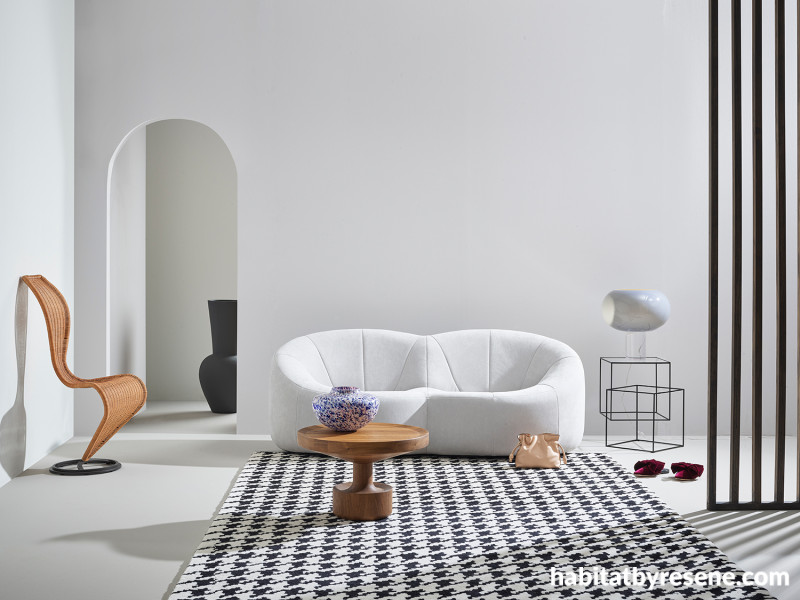
Turn the spotlight on your design’s best features with this trending painting technique
11 Feb 2025
If you spend any of your day interacting with social media, it might feel like you’re being bombarded by countless fleeting trends that are begging for your attention. Of course, not every design trend that gets touted online ends up taking hold in the real world, we love it when pragmatic painting ideas become popular. Enter: colour folding, a sophisticated yet sensible way to enhance spatial flow, define architectural features and bring a bespoke feel to your projects.
What is colour folding?
Rather than using a uniform colour across an entire space, colour folding involves the strategic use of multiple tones that appear to ‘wrap’ around corners, extend across different surfaces and subtly shift from one area to the next. This technique adds a dynamic, sculptural quality to interiors, making spaces feel more engaging and multidimensional.At its core, colour folding is about breaking the rigidity of ‘flat’colour application in favour of using paint to manipulate spatial perception. The effect can be subtle, using closely related hues to create a soft shift in tone.
Keep in mind that colour folding differs from colour blocking and feature walls because the transitions in colour are generally more subtle. Instead, think of it as a cousin of colour drenching; but rather than using one uniform colour from tip to toe, this trendleverages multiple strengths of a single Resene paint colour, a single colour family or analogous hues that have similar undertones.
In many cases, using a tonal colour palette – where all hues come from the same colour family with slight variations in shade, tint or saturation – creates the most aesthetically-pleasing result for colour folding. This approach is especially effective in spaces where a calm, cohesive atmosphere is desired. In bedrooms, spas or wellness spaces, usedifferent strengths of a soft blue such as Resene Triple Duck Egg Blue, Resene Duck Egg Blue and Resene Quarter Duck Egg Blue to enhance the feeling of serenity and relaxation.

Similarly, in minimalist or Scandinavian-inspired interiors where subtlety is key, shifting between different tones of grey, beige or muted greens that share a common undertone such as Resene Half Tana, Resene Quarter Linen and Resene Half Lemon Grass adds depth without overwhelming the space. Tonal colour folding is also ideal for small rooms or apartments, as it prevents abrupt changes that might visually shrink the space. Commercial offices, libraries and yoga or meditation spaces also benefit from this approach, as it fosters a sense of harmony and focus.

On the other hand, some interiors are better suited for bolder or more dramatic applications of colour folding by introducing contrast or blending analogous colour families. This technique is particularly effective in creative spaces, retail environments or modern hospitality settings where energy and visual impact are desirable. In a contemporary restaurant or boutique hotel, a striking transition from a saturated terracotta like Resene Coral Tree to a smouldering deep red like Resene Persian Red to a deep, red-edged brown like Resene Rebel defines different sections of the space while maintaining a cohesive design language. High-contrast colour folding is also useful in large, open-plan offices, where bold colour shifts help establish different work zones – keeping the space visually engaging yet unified.

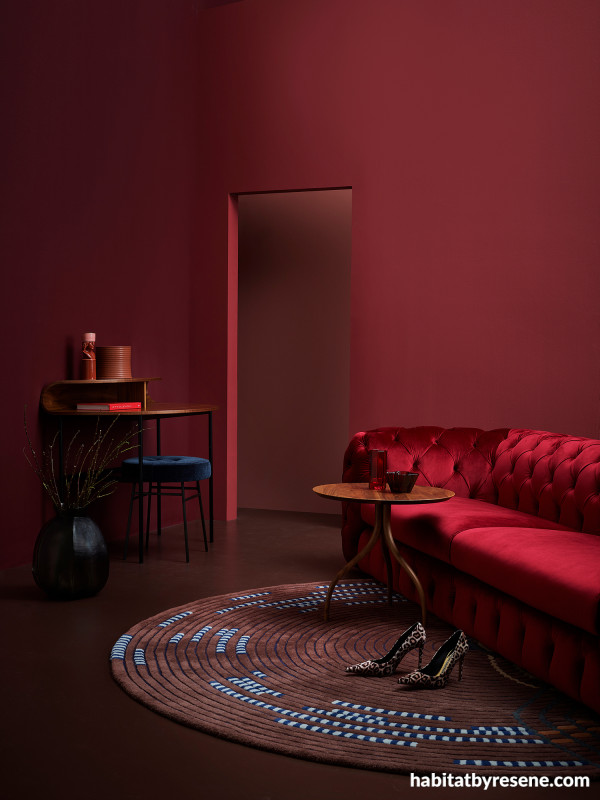
Left wall painted in Resene Persian Red, right wall in Resene Merlot, back wall (through doorway) in Resene Coral Tree and floor in Resene Rebel. Sofa from Bradfords Interiors, rug, desk and coffee table from Ligne Roset, floor vase from ECC.
Use colour folding to enhance architectural features
Colour folding is particularly effective in buildings with unique architectural elements such as alcoves, niches, beams or angled walls/ceilings. Instead of treating these features as separate from the main surfaces, colour folding integrates them into the design through a unified – but not uniform – palette. In a cosyroom with a sloped ceiling, rather than painting the walls one colour and the ceiling another, use a different strength of the same Resene colour to visually smooth the transition making the ceiling feel like an intentional design element rather than a structural limitation.Similarly, using a double or triple strength version of the same Resene colour creates depth and contrast without overwhelming the space, thanks to a unified colour palette.
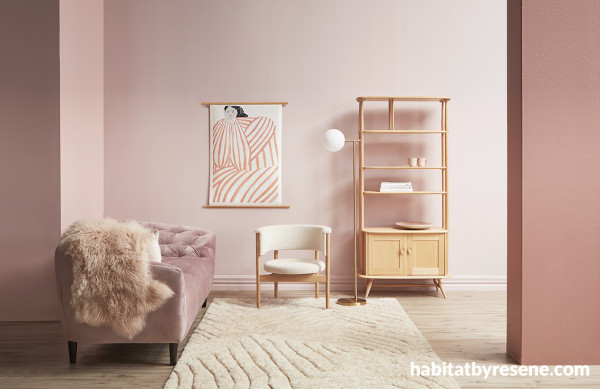
Back wall painted in Resene Wafer, left and return walls in Resene Sakura, floor finished in Resene Colorwood Rock Salt and pillar in Resene Brandy Rose. Shelving unit and chair from Good Form, lamp from Lighting Plus, sofa from Danske Møbler, rug, cushion and faux sheepskin from Mulberi, artwork from Slow Store, soapstone dish and cups from Città.
Leverage colour folding to define zones in open-plan spaces
In large open-plan areas, using a single uniform colour can make the room feel spacious but also lacking in definition. Traditionally, designers have addressed this by using feature or accent walls to mark functional zones. Colour folding, however, offers a more seamless alternative that allows subtler shifts in hue to delineate dining, lounging and workspace areas without the stark contrast of an accent wall. This approach is particularly useful in residential homesor commercial offices where maintaining a cohesive aesthetic is essential to your client.
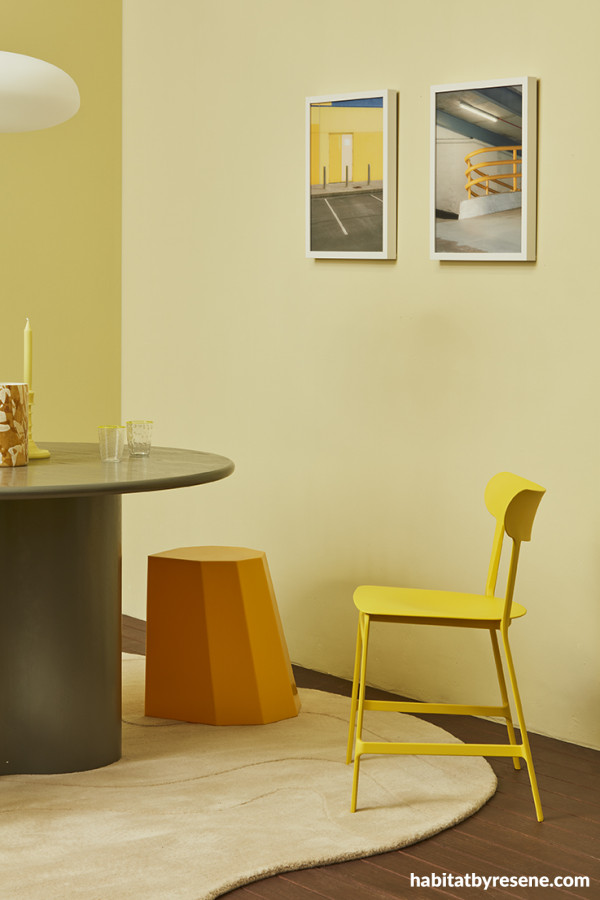
Left wall painted in Resene Lemon Twist, right wall painted in Resene Mint Julep and floor finished in Resene Colorwood Bark. Dining table from Soren Liv, chair from Noho, stool from Tessuti, artwork by Scott Cai from Sanderson Contemporary, rug and pendant lamp, from Ligne Roset, vase, candleholder and glassware from Faradays.
Build a sense of flow in small spaces with colour folding
In cosy and compact interiors, sudden shifts in colour can make rooms feel smaller by emphasising boundaries. Colour folding, however, allows for a gradual transition between hues so that these spaces feel more expansive and fluid. In a small hallway that leads into a lounge space, using a colour fold from a lighter to a deeper shade such as Resene Flotsam transitioning to Resene Gull Grey draws the eye forward, creating an illusion of depth and movement. This is especially effective in narrow or awkwardly shaped spaces where traditional colour blocking would feel too rigid.

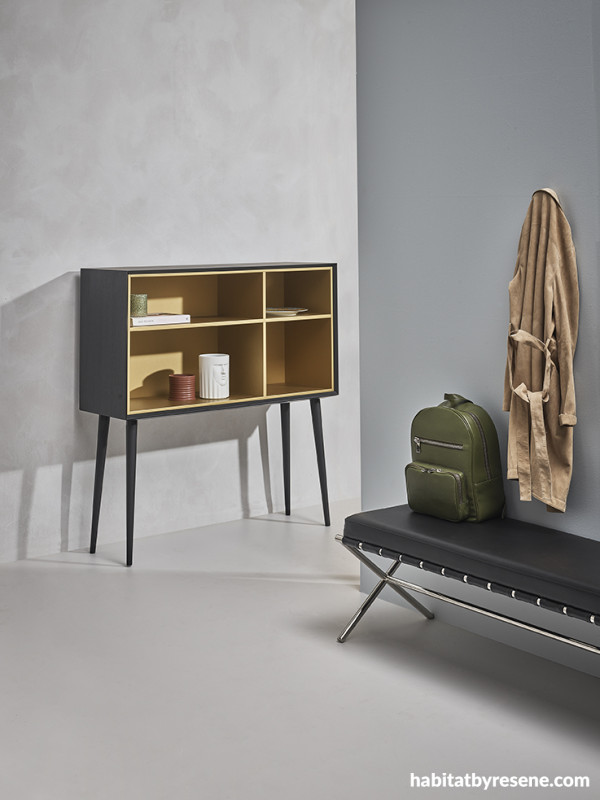
Left wall painted in Resene Flotsam with Resene FX Paint Effects Medium mixed with Resene Snow Drift applied on top, right wall in Resene Half Gull Grey and floor in Resene Flotsam. Sideboard from Ligne Roset, bench from Bradfords Interiors, candles and sculpture from Faradays, plate from Matt Joyce.
Employ colour folding to add visual interest without overwhelming
Feature walls, while effective, can sometimes appear overly deliberate or disconnected from the rest of a room’s design. Colour folding offers an alternative by integrating colour variations in a way that feels organic. Instead of a single statement wall, subtle colour shifts can highlight architectural forms, adding complexity and richness to a space without overpowering the overall aesthetic.
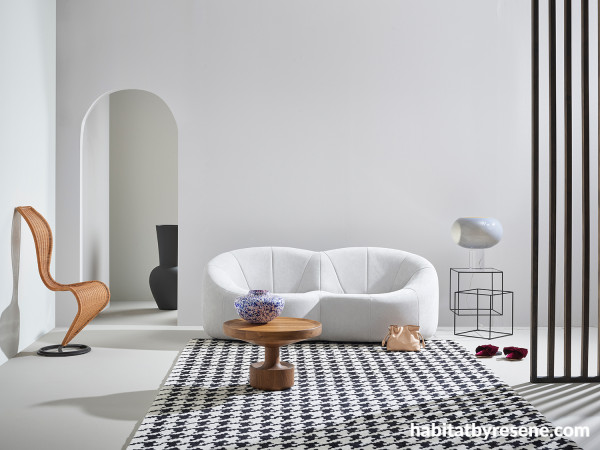
Wall with arched doorway painted in Resene Kinship, left wall and back wall (through doorway) in Resene Sea Fog, floor in Resene Stepping Stone, slatted timber screen stained in Resene Colorwood Tiri and large vase (on floor) in Resene Boris. Sofa and rug from Ligne Roset, side table and wicker chair from Matisse, coffee table and lamp from ECC, vase (on table) from Faradays.
Use colour folding to unify disjointed or multi-functional spaces
Colour folding is particularly useful in homes or commercial spaces where different areas serve multiple functions but need to feel cohesive. In older homes with extensions or renovations, for instance, there are often abrupt transitions between original structures and new additions. Rather than painting each section a different colour or using a stark contrast to define the old and new spaces, colour folding can create a smooth visual transition.
In a residential home where a contemporary extension joins with a traditional living area, a carefully placed colour shift bridges the two styles to ensure the space feels unified rather than disjointed. Similarly, in a multi-functional room – such as a studio apartment where the bedroom, office and lounge areas coexist within the same walls – colour folding subtly guides the eye from one function to another while maintaining a sense of flow and harmony.
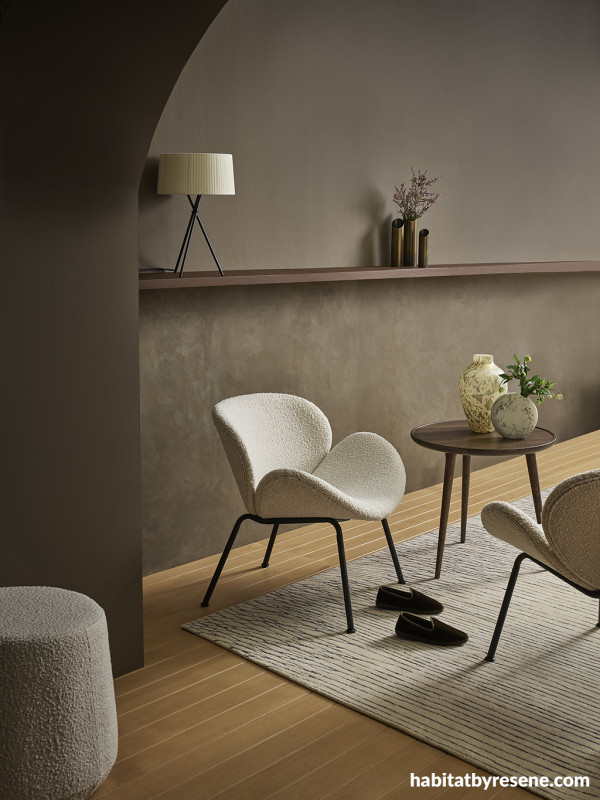
Archway and upper right wall painted in Resene Outlaw, shelf in Resene Allspice, lower right wall in Resene Outlaw with Resene FX Paint Effects Medium mixed with Resene Kia Kaha applied over the top and floor finished in Resene Colorwood Bask. Chairs and ottoman from Bradfords Interiors, side table, lamp and orb vase from ECC, rug from Ligne Roset, vases on shelf from Powersurge, glass vase (on table) from Faradays.
For the latest onemerging colour and decorating trends, check out our colour trend forecast in the most recent issue of BlackWhite magazine.If you’re not on the mailing list, you can pick up a copy at your local Resene ColorShop, peruse the online version or sign-up to receive future issues free.
projects Amber Armitage
images Wendy Fenwick
Published: 11 Feb 2025





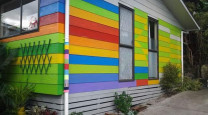








 look book
look book